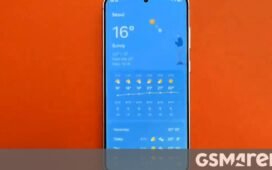This year’s Z60S Pro model bears a striking resemblance to last year’s Z50S Pro. We recently got the new device, though, so we still figured out it will be good to run some tests on it.
Before we get to the actual benchmark tests, let’s review what has changed in the new model. Despite the significant jump in the model number, it is more of a facelift than a straigh upgrade. Nubia boosted the main 35mm cam with a larger sensor. It also introduced some new AI features to the mix, including Magic Eraser, a star sky algorithm and a 65:24 ultra-wide cinema format.

The chipset situation is a bit weird. While the Z50S Pro gets the Snapdragon 8+ Gen 2 chipset, the new Z60S Pro has to settle for the slightly weaker Snapdragon 8 Gen 2. The difference between the two chips is small and seems mostly confined to the GPU, which is a bit higher clocked on the Snapdragon 8+ Gen 2 inside the older Z50S Pro. CPU-wise, both phones are pretty much identical, running the higher-clocked “AC” version of the Snapdragon chip. This includes a primary 3.36 GHz Arm Cortex-X3 core, accompanied by two 2.8 GHz Cortex-A715 cores, two 2.8 GHz Cortex-A710 and three 2.0 GHz Cortex-A510 ones.
Let’s kick off the tests with some CPU benchmarks and GeekBench. As mentioned, the Z60S Pro and Z50S Pro are on a level playing field in this department. Looking at the actual scores, the Z60S Pro has a slight edge, which is understandable since it is a newer device, running Android 14 instead of Android 13 at the time of testing and benefitting from various optimizations. Even so, the difference is within the margin of error, as it should be.
AnTuTu is a much more compound benchmark, also adding GPU, memory and storage scores. Here, we can see that the Z50S Pro has a slight edge over its successor. This is expected, given the slightly higher-clocked GPU. Plus, our Z50S Pro unit has 1TB of storage instead of 256GB on our Z60S Pro review unit.
Last but not least, we have some more GPU tests within 3DMark. As expected, both devices do great in this benchmark. There is a small difference in performance between the pair again, which favors the Z50S Pro, which has a higher GPU clock speed. Still, the difference is hardly major.
As expected, the performance delta between the Nubia Z50S Pro and the Z60S Pro is very small and only detectable in synthetic benchmarks. Still, it is a bummer that the newer Z60S effectively gets a lesser chipset than its predecessor. It doesn’t make any notable difference in real life, but it’s still very rarely that we see such a thing.















